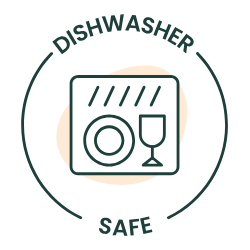What is Stainless Steel? A Guide to Grades, Safety & Sustainability
Stainless steel: the durable, shiny, and eco-friendly superstar in your kitchen! Learn what makes it unique, sustainable, and perfect for everyday use.

Ever wondered what makes stainless steel so special? You’re not alone! When I was developing the Greenvyne range, from our kids' plates to our upcoming lunch containers, I knew I needed a material that was durable, long-lasting, and completely safe for my family. My research led me straight to stainless steel, and I went deep into understanding everything about it. I wanted to know: What is stainless steel made of? Is it truly sustainable? And what’s the deal with different stainless steel grades? This is everything I learned about why this metal is the ultimate choice for eco-friendly and non-toxic kitchenware. So, let’s explore what makes this metal so remarkable and why it’s such a smart choice for our everyday lives.
What is Stainless Steel Made Of?
At its core, stainless steel is a type of metal alloy. It’s made primarily of iron and at least 10.5% chromium, which gives it that magical “stainless” property. The chromium forms an invisible layer on the surface, protecting the metal from rust and corrosion. That’s why your stainless steel water bottle still looks good as new after years of use.
But stainless steel isn’t just iron and chromium. Remember those periodic table elements we all tried to memorise in school? Don’t worry, I don’t either! What I do know is that elements like nickel, molybdenum, carbon, manganese, and titanium are often added to stainless steel to make it stronger, tougher, and more resistant to extreme conditions. And here’s the best part: a lot of the stainless steel we use today comes from recycled materials. Pretty cool, right? Stick around, and I’ll explain how that works!
How Is Stainless Steel Made?
Stainless steel starts its life as raw materials like iron ore, chromium, and nickel, which are either newly mined or recycled from old steel products. In fact, about 60% of stainless steel comes from recycling, which means you’re holding something that’s already had an amazing history before landing in your hands!
Here’s how it all comes together:
- Melting the Ingredients: The raw materials are melted in a furnace at scorching temperatures (think hotter than your oven at 1500°C or 2732°F).
- Mixing It Up: Additional elements like chromium or nickel are added to fine-tune the steel’s properties, making it tougher, shinier, or more resistant to specific conditions.
- Shaping It: The molten steel is cast into slabs, billets, or blooms. These are the building blocks for things like sheets, bars, and wires.
- Rolling and Heating: The steel is heated again and rolled out to the desired thickness.
- Polishing to Perfection: To achieve that gorgeous shine, the surface is treated and polished, making it not just functional but also aesthetically pleasing.
Pretty cool, right? Every shiny stainless steel spoon or water bottle you use has gone through this epic transformation!
Why Is Stainless Steel So Shiny?
That signature sparkle isn’t just for looks. The chromium in stainless steel reacts with oxygen in the air to create a super-thin, self-repairing layer of chromium oxide. This layer reflects light and protects the metal underneath from rust and stains. Polishing takes it a step further, giving stainless steel that mirror-like finish we love.
Understanding Stainless Steel Grades: 304 vs 316 vs 430
When we were deciding on the perfect material for Greenvyne products, I was amazed to learn that not all stainless steel is the same. Choosing the right stainless steel grade is crucial for safety and durability. It was a non-negotiable for me. Here’s a simple breakdown of the grades we use and why they matter for your family:
Is Stainless Steel Sustainable?
Yes, yes, and yes! Stainless steel is not only durable but also one of the most eco-friendly materials out there:
- Recyclable Forever: It’s 100% recyclable, meaning old stainless steel products can be melted down and reused endlessly without losing quality.
- Built to Last: Stainless steel can last decades, reducing waste and the need for replacements.
- Non-Toxic: Even if it ends up in a landfill, it doesn’t release harmful chemicals into the soil.
By choosing stainless steel products, you’re making a choice that’s better for your family—and the planet!
Is Nickel in Stainless Steel Safe? A Guide to Nickel Allergies
Let’s talk about nickel, one of the key ingredients in many stainless steel grades.
Is Nickel Safe?
As a fussy parent, this was something I looked into carefully. Is nickel in stainless steel safe? For the vast majority of people, the answer is a resounding yes. In fact, our bodies need a little nickel—it’s an essential trace element for the human body, helping enzymes function properly and supporting healthy cells (National Institutes of Health, 2021).
Did you know you already consume small amounts of nickel every day? Foods like nuts, beans, oats, chocolate, leafy greens, and even bananas naturally contain nickel. For most of us, this is completely harmless and might even contribute to overall health.
Nickel Allergies
However, some people are sensitive to nickel. When exposed to it, they may develop nickel allergy symptoms such as:
- Itchy rashes or redness (usually where skin contacts nickel-containing items).
- Dermatitis or dry patches.
If you’re one of the lucky few with a nickel allergy, don’t worry—there are stainless steel options for you, too. Nickel-free grades like 430 stainless steel are a safe choice.
Does Stainless Steel Release Nickel?
In certain conditions, like cooking acidic foods (think lemons or tomatoes) for long periods, trace amounts of nickel may leach from stainless steel. While these amounts are extremely low and safe for most people, those with allergies might want to avoid prolonged exposure to nickel-rich stainless steel grades like 304 or 316.
Why Stainless Steel Is Perfect for Kitchenware
Stainless steel isn’t just shiny—it’s a superhero in your kitchen! Here’s why:
- Hygienic: It’s non-porous, meaning bacteria and germs don’t stand a chance.
- Durable: Scratch-resistant, rust-proof, and built to last a lifetime.
- Safe: It doesn’t leach harmful chemicals (unlike plastics).
- Eco-Friendly: 100% recyclable and made to reduce waste.
A Lasting Choice
Stainless steel is more than just a material—it’s a commitment to durability, safety, and sustainability. From your kitchen to your lunchbox and even your medical care, stainless steel is everywhere, making life easier and greener.
At Greenvyne, we’re all about creating sustainable, long-lasting products you can trust.
By choosing stainless steel, you’re not just investing in a product; you’re investing in a better future—for yourself, your family, and the planet.
This commitment to safety is a big reason why we believe it's time for families to ditch plastic.
So next time you reach for that shiny stainless steel cup or plate, give it a little nod of appreciation. It’s not just shiny; it’s smart.
Happy Steeling!
– Vee
🌿
Disclaimer:
The information provided in this blog is for general informational purposes only and is not intended as medical or professional advice. If you have specific health concerns, such as a nickel allergy or other sensitivities, please consult a healthcare professional for personalised guidance. Greenvyne products are designed with care to ensure safety and sustainability; however, individual experiences may vary.














